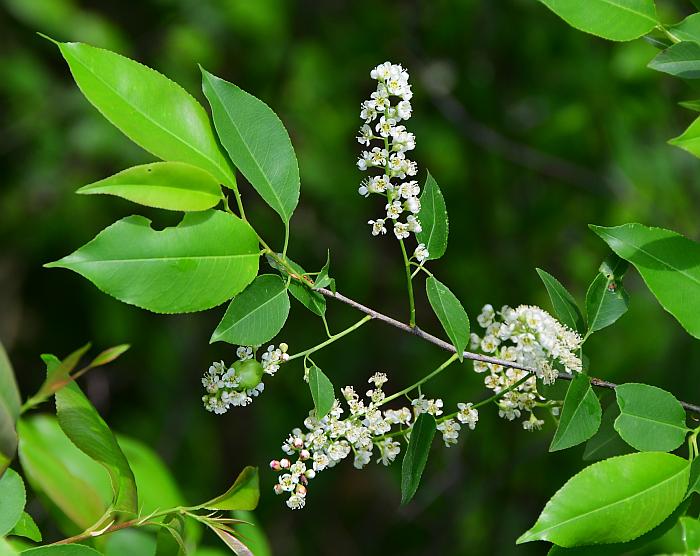Prunus serotina Ehrh.
Black Cherry

Native
CC = 2
CW = 3
MOC = 80
© SRTurner
Prunus serotina Ehrh.Black Cherry | |
 |
Native CC = 2 CW = 3 MOC = 80 |
© SRTurner |
|
Family - Rosaceae Habit - Tree, usually 10-15 m tall, not suckering. Stems - Branches unarmed. Twigs glabrous or sparsely pubescent with short, reddish brown, glandular hairs, producing a terminal winter bud. Older growth gray-brown with round to oval lenticels and black punctate dots. Twigs pungent when bruised or cut.
Leaves - Alternate, simple, petiolate, stipulate. Stipules narrowly linear, the margins toothed and frequently glandular, shed early. Petioles 10-18 mm long, glabrous, with usually 2 glands at or near the tip. Leaf blades 4.0-13.5 cm long, 1.7-5.8 cm wide, more than 2 times as long as wide, narrowly elliptic to elliptic or lanceolate, rarely obovate, angled to rounded at the base, angled or more commonly tapered to a sharply pointed tip, the margins simply toothed, the blunt to more or less sharp teeth mostly incurved to appressed, lacking glands, the upper surface glabrous and usually somewhat shiny, the undersurface pale, glabrous or short-hairy along the midvein toward the base. Leaf tissue with a distinctive odor when crushed.
Inflorescences - Produced after the leaves develop, terminal on current year's growth, racemes of 18-55 flowers, 8-16 cm long, the flower stalks 2-6 mm long, usually glabrous.
Flowers - Hypanthium 1.5-3.0 mm long, hemispheric to more or less bell-shaped, glabrous. Sepals 0.5-1.5 mm long, ascending to spreading or reflexed at flowering, oblong-triangular, sharply pointed at the tip and persistent after flowering, the margins lacking glands or sparsely glandular-toothed, the inner surface glabrous. Petals 5, distinct, 2-4 mm long, obovate to nearly circular, white. Stamens about 20, of varying lengths, borne at the rim of the hypanthium. Filaments green-translucent, to 3 mm long, glabrous. Anthers yellow when fresh, 1 mm long. Ovary superior, green to purplish, ovoid, unilocular, with 1 ovule. Style 1. glabrous, green, 2 mm long, thick. Stigma captiate.
Fruits Globose drupes 5-10 mm long, the surface dark purple to nearly black, glabrous, not glaucous, the fleshy layer well-developed, the stone subglobose, not flattened, the surface smooth to finely wrinkled. Flesh sweet to bitter in flavor.
Flowering - April - May. Habitat - Bottomland and mesic forests, upland prairies, streambanks, pond margins, fens, pastures, fencerows, old mines, railroads, roadsides, open to shaded, disturbed areas. Origin - Native to the U.S. and Canada. Other info. - This species can be found throughout Missouri and is quite common. The variety found in Missouri, var. serotina, also occurs throughout the eastern half of the continental U.S., its range coming to a sharp end along a longitudinal boundary running through eastern Nebraska and Kansas. When in flower it is easily recognized by its numerous racemes of fragrant white flowers. The bark is usually a distinctive dark gray in color, becoming furrowed with scaly plates on older specimens. The leaf petioles, as in all members of the genus, bear small glands near their junction with the leaf blade, and the crushed leaves emit a faint odor of benzaldehyde due to their content of the glycosidic cyanohydrin prunasin. Since another breakdown product of prunasin is hydrogen cyanide, the leaves (particularly storm-damaged foliage) can be toxic to grazing livestock. Photographs taken off Hwy 82, Bullock County, AL., 3-18-06 (DETenaglia); also near Labadie, Franklin County, MO, 4-29-2023 and 5-21-2023 (SRTurner). |